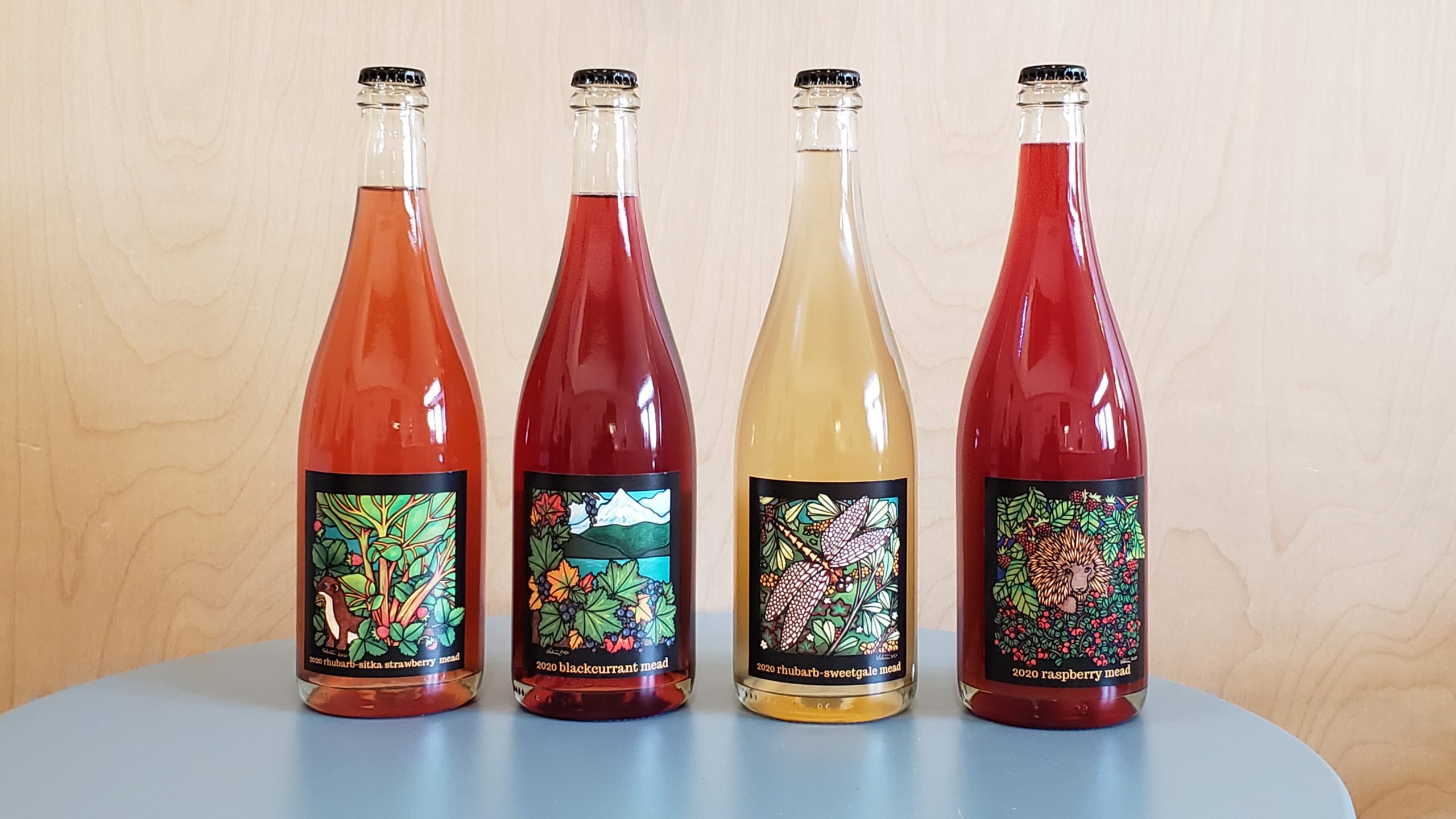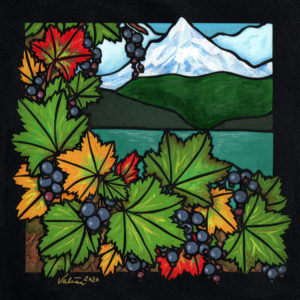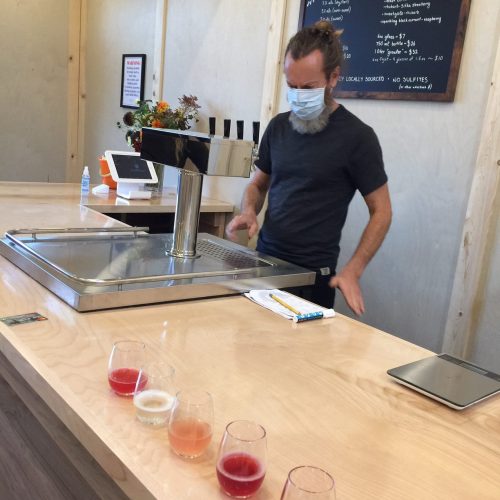Interviewing a plant expert is one of the course assignments of Applied EBOT 250 and 251. The following interview was conducted by Sundance Visser during EBOT 251, Applied Ethnobotany Spring and is part of her own project on fermentation with berries.

Bottles of mead from Sweetgale Meadworks, Homer, AK, Accessed 2/5/21 from https://sweetgalewines.com/
Jason Davis
Sweetgale Meadworks in Homer, Alaska
Interview: 1/27/21 (lightly edited for length and clarity)
Sweetgale Meadworks is a local (Homer, AK) meadery serving small-batch meads and ciders. Everything, seriously everything, in the product is local. Jason was very generous with his time and knowledge and talked with me for an hour (with masks on and from a distance). He has created a bright space in the middle of a challenging winter. He keeps two fires outside (one burning local spruce wood and one backup propane for busy days) ready for customers to cozy up to and enjoy a drink. Inside, the room is warm and colorful with local art by Valisa Higman, a rotating menu, and an oud (a Middle Eastern predecessor of the European lute) in the background. He answered all my questions and more with candor and great detail. His background in biology shines through, as well as his practicality and humor.

Art by Valisa Higman, Seldovia, AK, Retrieved 2/6/21 from https://sweetgalewines.com/
Introduce yourself and tell me why you decided to use wild yeast in your meads.
I got into winemaking when living on the Mediterranean. This concept of natural wines (using organic grapes fermented with nothing but the wild yeast that lives on them) was becoming popular. We decided to make some, and my daughter was two at the time helped stomp the grapes. It was so easy and delicious. We did that for 10 years. When our family relocated to Homer, I wasn’t interested in shipping up grape juice, so I decided not to make wine. I started keeping bees in high school, and I got going again back in Homer. We moved into a house with a big raspberry patch, and I started thinking about berry wines. Raspberry wines are highly regarded, the closest to so-called real wine. I got excited by the idea of making raspberry wine. The main ingredient by far is white sugar. It didn’t seem appealing to me. I thought I could take the honey from my bees and try using that in the place of white sugar. I didn’t really want to order yeast from France as you would typically do. The winemaking books in America tell you not to even try to use wild yeast because it will taste bad. We’re not like the Europeans who have been making wine for centuries and have all this wine yeast in the air. I also do a lot of sourdough and fermenting vegetables. I thought to myself that if you could get a starter going the way you do with sourdough, I don’t see why it would have off-flavors. If you make your own sourdough starter, at first it will taste nasty. You take a little bit and freshen it up with more flour and water over and over so only the most active and efficient yeast are there. And then you have a really yummy fresh-tasting sourdough. At first, I started making little batches of wine with raspberries, a little honey, and a lot of water. After a couple of days, I would take a little of that as my starter and I would do it again. After a while, it got to where I would take a teaspoon and put it in a new mix, and it would be fizzing in 24 hours! So I had my starter. I was making one bottle at a time in my house. Pretty soon I had a blackcurrant and a raspberry going, and I had two separate yeast strains. Those are my two favorites. The neighbors loved it. I gave bottles away. So eventually people wanted to buy it from me. In Alaska, you can sell up to $25,000-worth of stuff that you make in your home without a special kitchen, so I was hoping there would be something like that for wine or mead. There is for kombucha, but for mead and wine, you can’t sell one bottle unless you have a license to be a winery. In order to do that you have to have control of a kitchen that’s licensed by the Department of Environmental Conservation (DEC) that’s in an industrial zone and separate from your home. All of a sudden, the only way I could make wine to sell was to buy a place in downtown Homer that had a kitchen.
I like the idea of being local just in principle, but before I went commercial, I ordered some special champagne yeast from France that’s recommended for mead. I did a side-by-side fermentation thinking that the batch with the French yeast would come out better, but if it wasn’t a lot better, I was going to stick with local just because of the principle of being local and because it’s free. It was amazing! The nose on the local one was stronger; you could smell the berry 3 or 4 times more. So that’s also why, because it’s actually better!
What’s your favorite part of the process?
The beekeeping. I can’t wait for summer! I like the winemaking part as well, but it’s kind of mechanical. You fill a vat with water, dump in some honey and mix it up. You dump in some berries. You stir it once a day for 8 days, and you’re done. Growing and picking the berries, and keeping the bees, is exciting and fun. It is nice to be growing and cultivating something in the winter. But it’s not magical.
Science and magic. Do you find that you lean one way or the other, especially when considering the unpredictability of your inputs?
I am a biology major, so I have a science background. I would say that the only science aspect of what I do is to keep records of how many kilos of berries and honey I use. I adjust the honey to make 12% potential alcohol. Some honeys are more watery, so I have to add more. If you add more berries, the result is darker but not necessarily more delicious. So I write down my formula for the batch, and I keep all the batches numbered. You taste it two months after making it, so this way I can go back and see.
Sweetgale is a special plant. Can you tell me about it?
Growing up in Soldotna, I loved that plant. It was growing behind the house and whenever people came over, I would lead little tours of the area and let them taste the blueberries. I would always make them smell the sweetgale. Later, I found out the Vikings used it to flavor their mead. The Vikings and Northern European brewers tended to use a mixture of three different plants: wormwood, sweetgale, and yarrow. I made a mead like that, but I didn’t like it. It tasted very medicinal to me, but I couldn’t tell where the medicinal part was coming from. I made one from each plant. The wormwood mead was very bitter but didn’t have an interesting flavor. The yarrow tasted very weird and medicinal. The sweetgale, to me, just tasted lovely.

Myrica gale L., Retrieved on 2/6/21 from http://nativeplantspnw.com/sweet-gale-myrica-gale/
Have you gotten more in touch with the local food community?
Totally. I love that part of it. So many of the people who bring me berries are Russians from the Old Believer communities from up the hill. Their raspberries are like that big. I need to figure out their secret. They’re massive!
Where do you see Sweetgale Meadwords in the local food network? Who have you been connecting with?
I work with one permaculture farmer in Ninilchik named Shawn Jackinsky. His blackcurrants are bigger and more delicious than other people’s, so I bought everything he grew last year. It lasted two months. I bought all the black currants in Homer that I could find, but I’m out now. I’m about to run out of raspberries, so I’m going to put out a call. I think the Russians are going to come through. The biggest challenge is getting enough berries to get through because they only come once a year. You have to freeze them, and I don’t have a big enough freezer. I may try to figure out what a good solution is for a freezer.
And the honey?
I started with my own honey but it lasted about a month. I bought from four different beekeepers here in Homer, but there doesn’t seem to be anyone left with 5-gallon buckets they can sell me. There’s a guy in Eagle River (235 miles away), which is still the same region of Southcentral Alaska. He has a garage full of his fireweed honey. He’ll sell it to me at a wholesale price that works if I buy 25 buckets at a time.
How do you transport that?!?
I have a Toyota 4Runner, and if you stack them double and put three in the passenger seat, then it will hold 25 buckets, that’s how.
So honey is the expensive input?
There is $10 (at local retail prices) of honey per bottle of mead. To sell honey at the retail price, you have to put it in little jars. People are really happy if I offer them $700 for a bucket of honey. I’m getting ready to send out a note to the beekeepers. I feel there are a lot of people who enjoy beekeeping, but there’s not a lot of market for new people to start selling little jars of honey for $30 each. I want to tell people that from a hive you should easily get two of those buckets. I’ll give you a $1400 check, so if you buy $225-worth of bees, you’re doing pretty good. I’m tripling my own beekeeping this year. The fewer trips I can make to Eagle River, the better.
Are there other end-of-the-road logistics that you’ve had to deal with being out here?
The glass. I have to order bottles, champagne bottles. When fermenting with natural yeast, the mead ferments a little in the bottle. If the bottles were regular glass with corks, they would probably blow up. It’s not easy to find clear champagne bottles, but I want people to be able to see the color. The only ones I’ve been able to find are from Montreal, Canada, so it’s been a nightmare to ship through Seattle. There was a strike in September in the Port of Montreal, so the bottles I ordered two months prior were delayed. Finally, the company asked if they could send me some others that weigh twice as much, at their expense. Ok, but now they literally weigh a ton. I’m getting a new shipment of the lighter ones which hopefully will go well.
Have you done or thought about doing anything to build resilience into your business?
I put a very minimal amount into this business because I had no confidence that it would actually go. I got a new credit card with a $16,000 limit that you don’t pay interest on until September of next year. That and some savings were pretty much all. I bought the building, so there’s the mortgage. I rent out the space next door, and that pays the mortgage. I really don’t have costs except for the honey. Initially, I was using my own honey and saw that the business was going well. Then I was getting honey from people locally and saw that it was still going well. I ran out of local honey and had to buy $16,000 of honey from the guy in Eagle River. I put it on my regular credit card believing I would sell enough over Christmas to pay it off, and I did. That kind of stuff, I think. I don’t have to make a lot to stay afloat.
So what are you excited about now?
The bees. I’ve learned a lot, and I have new strategies to use that I’m excited about. On the meadery front, there’s one particular berry that I’ve been obsessed with since I was in about fourth grade. It’s called a nagoonberry. It’s so special. When you smell it, it’s like something you’ve never smelled before. I learned that it’s considered the most aromatic berry in the world. In Finland, it’s their national obsession, and they make these liqueurs from it. So here’s the deal. I learned that in the 1970s, they were having trouble growing it commercially. When they’d grow too many together, the plants would succumb to white mildew. They launched a national research project to try to find varieties of the plant around the world that would be big and aromatic like theirs are and also be resistant to this white mildew. They gathered different subspecies from around Russia, Greenland, Canada, and Alaska. They found a subspecies (Rubus arcticus ssp. acaulis) on the Kenai peninsula that aggressively spreads vegetatively but fruits rarely. Its flowers are lovely, aromatic, and make a nice mead, by the way. It’s extremely mildew resistant. They bred it with their local varieties, and they created two cultivars (called Anna and Beta). You can buy them. So I bought them. And I planted them. I got enough berries to make one bottle of wine. It was the most delicious wine that I’ve ever tasted in my life, like of any kind. Forget about grapes! It’s so amazing. I bought 1000 plants and planted them in my garden. This year I should be able to make five gallons of nagoonberry wine, and it’s going to be so unbelievable.
Thank you, Jason! I am now incredibly excited for summer and for nagoonberries!

Jason Davis, owner, Sweetgale Meadworks, Homer, AK, Accessed 2/5/21 at https://sweetgalewines.com/



